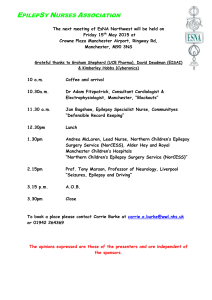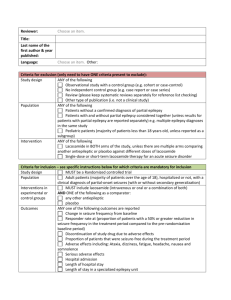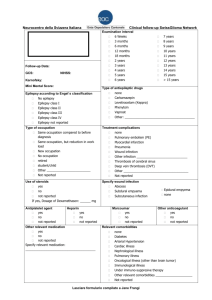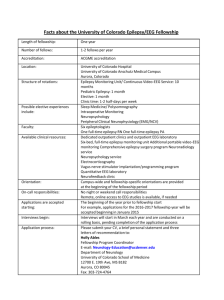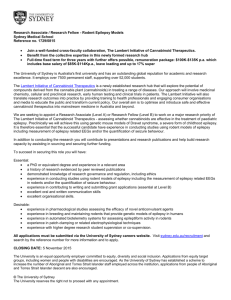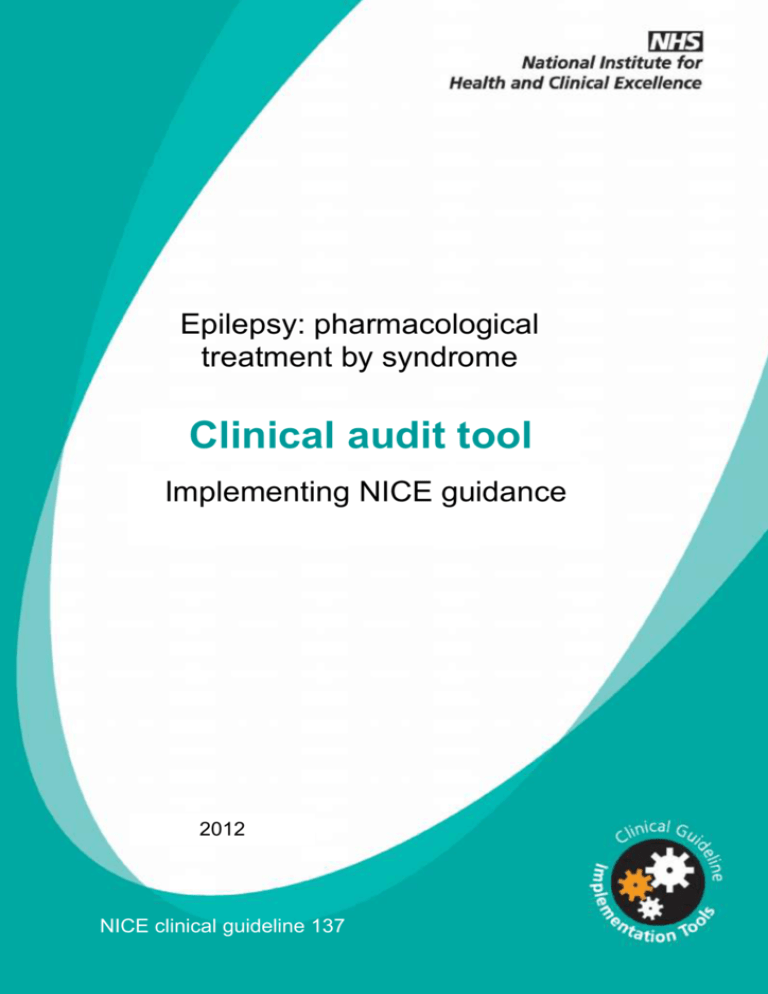
Epilepsy: pharmacological
treatment by syndrome
Clinical audit tool
Implementing NICE guidance
2012
NICE clinical guideline 137
Clinical audit tool: Epilepsy (2012)
Page 1 of 34
This clinical audit tool accompanies the clinical guideline: ‘The epilepsies: the
diagnosis and management of the epilepsies in adults and children in primary and
secondary care’ (available online at www.nice.org.uk/CG137).
Issue date: 2012
This is a support tool for clinical audit based on the NICE guidance.
It is not NICE guidance.
Implementation of this guidance is the responsibility of local commissioners and/or
providers. Commissioners and providers are reminded that it is their responsibility
to implement the guidance, in their local context, in light of their duties to avoid
unlawful discrimination and to have regard to promoting equality of opportunity.
Nothing in this guidance should be interpreted in a way which would be inconsistent
with compliance with those duties.
National Institute for Health and Clinical Excellence
Level 1A, City Tower, Piccadilly Plaza, Manchester M1 4BT; www.nice.org.uk
© National Institute for Health and Clinical Excellence, 2012. All rights reserved. This
material may be freely reproduced for educational and not-for-profit purposes. No
reproduction by or for commercial organisations, or for commercial purposes, is allowed
without the express written permission of NICE.
Clinical audit tool: Epilepsy (2012)
Page 2 of 34
Using this clinical audit tool
The clinical audit tool can be used to measure current practice in the
pharmacological treatment of epilepsy against the recommendations in the NICE
guideline. Use it for a local audit project either by using the whole tool or by
amending it to suit the project.
The clinical audit tool contains criteria and a data collection tool. The data collection
tool can be used or adapted for the data collection part of the clinical audit cycle by
the trust, service or practice. This document includes the following sections, each
containing audit criteria and a data collection form:
Infantile spasms
Dravet syndrome
Lennox-Gastaut syndrome
Benign epilepsy with centrotemporal spikes, Panayiotopoulos syndrome or lateonset childhood occipital epilepsy (Gastaut)
Idiopathic generalised epilepsy (IGE)
Juvenile myoclonic epilepsy
Epilepsy with generalised tonic-clonic seizures
Childhood absence epilepsy, juvenile absence epilepsy or other absence epilepsy
syndromes
Other epilepsy syndromes
A baseline assessment tool is also available
http://guidance.nice.org.uk/CG137/BaselineAssessment/xls/English. This can help
ascertain your Trust’s baseline against the guideline’s recommendations and
enable you to prioritise implementation activity including clinical audit.
The sample for this audit should include people with epilepsy. Select an appropriate
sample in line with your project aims or local clinical audit strategy.
Whether or not the audit results meet the standard, re-auditing is a key part of the
audit cycle. If your first data collection shows room for improvement, re-run it once
Clinical audit tool: Epilepsy (2012)
Page 3 of 34
changes to the service have had time to make an impact. Continue with this
process until the results of the audit meet the standards.
Links with other clinical audit priorities
The audit based on this guideline should be considered in conjunction with other
clinical audit priorities such as:
Epilepsy12 national audit: http://www.rcpch.ac.uk/epilepsy12
Clinical audit tool: Epilepsy (2012)
Page 4 of 34
Criteria for Epilepsy: pharmacological treatment by
syndrome
Infantile spasms
Criterion 1
When an infant presents with infantile spasms, their treatment should be
discussed with, or referred to, a tertiary paediatric epilepsy specialist.
Exceptions
None
Guideline reference
1.9.8.1
Definitions
None
Criterion 2
Prednisolone, tetracosactide1 or vigabatrin should be offered as first-line
treatment in infantile spasms that are not due to tuberous sclerosis.
Exceptions
None
Guideline reference
1.9.8.2
Definitions
The risk–benefit ratio should be considered carefully when using vigabatrin or
steroids.
Criterion 3
Vigabatrin should be offered as first-line treatment in infantile spasms
due to tuberous sclerosis.
Exceptions
None
Guideline reference
1.9.8.3
Definitions
The risk–benefit ratio should be considered carefully when using vigabatrin or
steroids.
Criterion 4
If vigabatrin is ineffective in infantile spasms due to tuberous sclerosis,
prednisolone or tetracosactide7 should be offered.
Exceptions
None
Guideline reference
1.9.8.3
Definitions
The risk–benefit ratio should be considered carefully when using vigabatrin or
steroids.
1
At the time of publication (January 2012), this drug did not have UK marketing authorisation for this indication
and/or population. Informed consent should be obtained and documented.
Clinical audit tool: Epilepsy (2012)
Page 5 of 34
Data collection tool for ‘Epilepsy’
Complete one form for each patient.
Patient identifier:
Sex:
Age:
Organisation/service:
Ethnicity:
White
British
Irish
Any other
White
background
No.
Data
item
no.
Mixed
White and
Black Caribbean
White and
Black African
Asian or Asian British
Indian
Black or Black British
Caribbean
Pakistani
African
Any other
ethnic group
White and
Asian
Bangladeshi
Any other Black
background
Not stated
Any other mixed
background
Any other Asian
background
Criteria
Yes
Other
Chinese
No
Infantile spasms
Was treatment discussed with, or referred to, a tertiary paediatric
epilepsy specialist?
1
1.1
discussed
1.2
referred
If the infant had infantile spasms that were not due to tuberous
sclerosis were any of the following offered as first-line treatment?
2
3
2.1
prednisolone
2.2
tetracosactide
2.3
vigabatrin
2.4
other
3.1
If the infant had infantile spasms that were due to tuberous sclerosis
was vigabatrin offered?
If vigabatrin was ineffective in infantile spasms due to tuberous
sclerosis, were any of the following offered?
4
4.1
prednisolone
4.2
tetracosactide
4.3
other
Clinical audit tool: Epilepsy (2012)
Page 6 of 34
NA/
Exceptions
Criteria for Epilepsy: pharmacological treatment by
syndrome
Dravet syndrome
Criterion 5
When a child presents with suspected Dravet syndrome, their treatment
should be discussed with, or referred to, a tertiary paediatric epilepsy
specialist.
Exceptions
None
Guideline reference
1.9.9.1
Definitions
None
Criterion 6
Sodium valproate or topiramate2 should be considered as first-line
treatment.
Exceptions
None
Guideline reference
1.9.9.2
Definitions
Sodium valproate and topiramate should be considered but do not necessarily
have to be offered, therefore a standard of 100% cannot be set.
Criterion 7
If first-line treatments are ineffective or not tolerated, the patient’s
treatment should be discussed with a tertiary epilepsy specialist.
Clobazam1 or stiripentol should be considered as adjunctive treatment.
Exceptions
None
Guideline reference
1.9.9.3
Definitions
Clobazam and stiripentol should be considered but do not necessarily have to
be offered, therefore a standard of 100% cannot be set.
Criterion 8
Carbamazepine, gabapentin, lamotrigine, oxcarbazepine, phenytoin,
pregabalin, tiagabine or vigabatrin should not be offered.
Exceptions
None
Guideline reference
1.9.9.4
Definitions
None
2
At the time of publication (January 2012), this drug did not have UK marketing authorisation for this indication
and/or population. Informed consent should be obtained and documented.
Clinical audit tool: Epilepsy (2012)
Page 7 of 34
Data collection tool for Epilepsy: pharmacological
treatment by syndrome
Complete one form for each patient.
Patient identifier:
Sex:
Age:
Organisation/service:
Ethnicity:
White
British
Irish
Any other
White
background
No.
Data
item
no.
Mixed
White and
Black Caribbean
White and
Black African
Asian or Asian British
Indian
Black or Black British
Caribbean
Pakistani
African
Any other
ethnic group
White and
Asian
Bangladeshi
Any other Black
background
Not stated
Any other mixed
background
Any other Asian
background
Criteria
Other
Chinese
Yes
No
Dravet syndrome
Was treatment discussed with, or referred to, a tertiary paediatric
epilepsy specialist?
5
5.1
discussed
5.2
referred
6
7
Were any of the following prescribed as first-line treatment?
6.1
sodium valproate
6.2
topiramate
6.3
other
7.1
If first-line treatment was ineffective or not tolerated, was treatment
discussed with a tertiary paediatric epilepsy specialist?
Were either of the following prescribed as adjunctive treatment?
7.2
clobazam
7.3
stiripentol
8
Were any of the following offered?
8.1
carbamazepine
8.2
gabapentin
8.3
lamotrigine
8.4
oxcarbazepine
8.5
phenytoin
8.6
pregabalin
8.7
tiagabine
8.8
vigabatrin.
Clinical audit tool: Epilepsy (2012)
Page 8 of 34
NA/
Exceptions
Criteria for Epilepsy: pharmacological treatment by
syndrome
Lennox–Gastaut syndrome
Criterion 9
When a child presents with suspected Lennox–Gastaut syndrome, their
treatment should be discussed with, or referred to, a tertiary paediatric
epilepsy specialist.
Exceptions
None
Guideline reference
1.9.10.1
Definitions
None
Criterion 10
Sodium valproate should be offered as first-line treatment to children
with Lennox–Gastaut syndrome.
Exceptions
B – sodium valproate is unsuitable
Guideline reference
1.9.10.2
Definitions
When prescribing sodium valproate to women and girls of present and future
childbearing potential, discuss the possible risk of malformation and
neurodevelopmental impairments in an unborn child, particularly with high
doses of this drug or when using as part of polytherapy.
Criterion 11
Lamotrigine should be offered as adjunctive treatment if first-line
treatment with sodium valproate is ineffective or not tolerated.
Exceptions
None
Guideline reference
1.9.10.3
Definitions
None
Criterion 12
If adjunctive treatment is ineffective or not tolerated, the patient’s
treatment should be discussed with a tertiary epilepsy specialist.
Treatment with rufinamide and topiramate can be considered by the
tertiary epilepsy specialist.
Exceptions
None
Guideline reference
1.9.10.4
Definitions
Rufinamide and topiramate should be considered but do not necessarily have
to be offered, therefore a standard of 100% cannot be set.
Clinical audit tool: Epilepsy (2012)
Page 9 of 34
Felbamate3 should only be offered in centres providing tertiary epilepsy
specialist care and when treatment with all of the drugs listed below has
proved ineffective or not tolerated:
Criterion 13
lamotrigine
rufinamide
topiramate.
Exceptions
None
Guideline reference
1.9.10.6
Definitions
None
Criterion 14
Carbamazepine, gabapentin, oxcarbazepine, pregabalin, tiagabine or
vigabatrin should not be offered.
Exceptions
None
Guideline reference
1.9.10.5
Definitions
None
3
At the time of publication (January 2012), this drug did not have UK marketing authorisation for this indication
and/or population. Informed consent should be obtained and documented.
Clinical audit tool: Epilepsy (2012)
Page 10 of 34
Data collection tool for Epilepsy: pharmacological
treatment by syndrome
Complete one form for each patient.
Patient identifier:
Sex:
Age:
Organisation/service:
Ethnicity:
White
British
Irish
Any other
White
background
No.
Data
item
no.
Mixed
White and
Black Caribbean
White and
Black African
Asian or Asian British
Indian
Black or Black British
Caribbean
Pakistani
African
Any other
ethnic group
White and
Asian
Bangladeshi
Any other Black
background
Not stated
Any other mixed
background
Any other Asian
background
Criteria
Yes
Other
Chinese
No
NA/
Exceptionsa
Lennox–Gastaut syndrome
Was treatment discussed with, or referred to, a tertiary paediatric
epilepsy specialist?
9
9.1
discussed
9.2
referred
10
10.1
Was sodium valproate offered?
11
11.1
If sodium valproate was ineffective or not tolerated, was lamotrigine
offered as adjunctive treatment?
12
12.1
If adjunctive treatment was ineffective or not tolerated, was
treatment discussed with a tertiary epilepsy specialist?
B
Were either of the following prescribed?
13
12.2
rufinamide
12.3
topiramide
13.1
If felbamate was offered, was it offered by a centre providing tertiary
epilepsy specialist care?
Had the drugs listed below proved ineffective or not tolerated?
13.2
lamotrigine
13.3
rufinamide
13.4
topiramate
Clinical audit tool: Epilepsy (2012)
Page 11 of 34
No.
Data
item
no.
14
Criteria
Yes
No
NA/
Exceptionsa
Were any of the following offered?
14.1
carbamazepine
14.2
gabapentin
14.3
oxcarbazepine
14.4
pregabalin
14.5
tiagabine
14.6
vigabatrin.
a Circle
exception codes as appropriate. Details of exceptions are listed at the end of the patient data collection tool.
Exception codes
B – sodium valproate is unsuitable
Clinical audit tool: Epilepsy (2012)
Page 12 of 34
Criteria for Epilepsy: pharmacological treatment by
syndrome
Benign epilepsy with centrotemporal spikes, Panayiotopoulos syndrome or
late-onset childhood occipital epilepsy (Gastaut type)
Criterion 15
A discussion should take place with the child or young person and their
family and/or carers about whether drug treatment is indicated.
Exceptions
None
Guideline reference
1.9.11.1
Definitions
This discussion may not be recorded. Only use this criterion if discussions are
routinely recorded by clinicians locally.
Criterion 16
Carbamazepine4 or lamotrigine4 should be offered as first-line treatment
to children and young people.
Exceptions
None
Guideline reference
1.9.11.2
Definitions
None
Criterion 17
If carbamazepine and lamotrigine are unsuitable or not tolerated,
levetiracetam4, oxcarbazepine4 or sodium valproate should be offered.
Exceptions
None
Guideline reference
1.9.11.3
Definitions
Carbamazepine and oxcarbazepine may exacerbate or unmask continuous
spike and wave during slow sleep, which may occur in some children with
benign epilepsy with centrotemporal spikes.
Levetiracetam is not cost effective at June 2011 unit costs4. Offer
levetiracetam provided the acquisition cost of levetiracetam falls to at least
50% of June 2011 value.
When prescribing sodium valproate to women and girls of present and future
childbearing potential, discuss the possible risk of malformation and
neurodevelopmental impairments in an unborn child, particularly with high
doses of this drug or when using as part of polytherapy.
4
Estimated cost of a 1500 mg daily dose was £2.74 at June 2011. Cost taken from the National Health Service
Drug Tariff for England and Wales, available at www.ppa.org.uk/ppa/edt_intro.htm
Clinical audit tool: Epilepsy (2012)
Page 13 of 34
Criterion 18
Carbamazepine4, clobazam5, gabapentin4, lamotrigine4, levetiracetam4,
oxcarbazepine4, sodium valproate or topiramate4 should be offered as
adjunctive treatment if first-line treatments are ineffective or not
tolerated.
Exceptions
None
Guideline reference
1.9.11.5
Definitions
When prescribing sodium valproate to women and girls of present and future
childbearing potential, discuss the possible risk of malformation and
neurodevelopmental impairments in an unborn child, particularly with high
doses of this drug or when using as part of polytherapy.
Criterion 19
If adjunctive treatment is ineffective or not tolerated, the patient’s
treatment should be discussed with, or referred to, a tertiary epilepsy
specialist.
Treatment with eslicarbazepine acetate6, lacosamide5, phenobarbital,
phenytoin, pregabalin5, tiagabine5, vigabatrin5 and zonisamide5 can be
considered.
Exceptions
None
Guideline reference
1.9.11.6
Definitions
The risk–benefit ratio should be considered carefully when using vigabatrin
because of the risk of an irreversible effect on visual fields.
5
At the time of publication (January 2012), this drug did not have UK marketing authorisation for this indication
and/or population. Informed consent should be obtained and documented.
6
At the time of publication (January 2012), this drug did not have UK marketing authorisation for this indication
and/or population. Informed consent should be obtained and documented.
Clinical audit tool: Epilepsy (2012)
Page 14 of 34
Data collection tool for Epilepsy: pharmacological
treatment by syndrome
Complete one form for each patient.
Patient identifier:
Sex:
Age:
Organisation/service:
Ethnicity:
White
British
Irish
Any other
White
background
No.
Data
item
no.
Mixed
White and
Black Caribbean
White and
Black African
Asian or Asian British
Indian
Black or Black British
Caribbean
Pakistani
African
Any other
ethnic group
White and
Asian
Bangladeshi
Any other Black
background
Not stated
Any other mixed
background
Any other Asian
background
Criteria
Yes
Other
Chinese
No
NA/
Exceptions
Benign epilepsy with centrotemporal spikes, Panayiotopoulos syndrome or late-onset
childhood occipital epilepsy (Gastaut type)
15
15.1
16
Is there evidence of a discussion with the child or young person and
their family and/or carers about whether drug treatment was
indicated?
Were any of the following offered as first-line treatment?
16.1
carbamazepine
16.2
lamotrigine
16.3
other
If carbamazepine and lamotrigine were unsuitable or not tolerated,
were any of the following offered?
17
17.1
levetiracetam
17.2
oxcarbazepine
17.3
sodium valproate
17.4
other
If first-line treatments were ineffective or not tolerated, were any of
the following offered?
18
18.1
carbamazepine
18.2
clobazam
18.3
gabapentin
18.4
lamotrigine
18.5
levetiracetam
18.6
oxcarbazepine
18.7
sodium valproate
Clinical audit tool: Epilepsy (2012)
Page 15 of 34
No.
19
Data
item
no.
Criteria
18.8
topiramate
19.1
If adjunctive treatment was ineffective or not tolerated, was
treatment discussed with, or referred to, a tertiary epilepsy
specialist?
Yes
No
Were any of the following prescribed as adjunctive treatment?
19.2
eslicarbazepine acetate
19.3
lacosamide
19.4
phenobarbital
19.5
phenytoin
19.6
pregabalin
19.7
tiagabine
19.8
vigabatrin
19.9
zonisamide
Clinical audit tool: Epilepsy (2012)
Page 16 of 34
NA/
Exceptions
Criteria for Epilepsy: pharmacological treatment by
syndrome
Idiopathic generalised epilepsy (IGE)
Criterion 20
Sodium valproate should be offered as first-line treatment.
Exceptions
B – sodium valproate is unsuitable
Guideline reference
1.9.12.1
Definitions
Sodium valproate is the preferred option if there is a photoparoxysmal
response on EEG.
When prescribing sodium valproate to women and girls of present and future
childbearing potential, discuss the possible risk of malformation and
neurodevelopmental impairments in an unborn child, particularly with high
doses of this drug or when using as part of polytherapy.
Criterion 21
Lamotrigine7 should be offered if sodium valproate is unsuitable or not
tolerated.
Exceptions
None
Guideline reference
1.9.12.2
Definitions
Lamotrigine can exacerbate myoclonic seizures. If JME is suspected see the
recommendations in section 1.9.13 of the guideline.
Criterion 22
Topiramate6 should be considered as a treatment option.
Exceptions
None
Guideline reference
1.9.12.3
Definitions
Topiramate has a less favourable side-effect profile than lamotrigine and
sodium valproate.
Topiramate can be considered but does not necessarily have to be offered,
therefore a standard of 100% cannot be set.
Criterion 23
Lamotrigine6, levetiracetam6, sodium valproate or topiramate6 should be
offered as adjunctive treatment if first-line treatment is ineffective or not
tolerated.
Exceptions
None
Guideline reference
1.9.12.4
Definitions
When prescribing sodium valproate to women and girls of present and future
childbearing potential, discuss the possible risk of malformation and
neurodevelopmental impairments in an unborn child, particularly with high
doses of this drug or when using as part of polytherapy.
7
At the time of publication (January 2012), this drug did not have UK marketing authorisation for this indication
and/or population. Informed consent should be obtained and documented.
Clinical audit tool: Epilepsy (2012)
Page 17 of 34
Criterion 24
If adjunctive treatment is ineffective or not tolerated, the patient’s
treatment should be discussed with, or referred to, a tertiary epilepsy
specialist.
Treatment with clobazam6, clonazepam or zonisamide6 should be
considered by the tertiary epilepsy specialist.
Exceptions
None
Guideline reference
1.9.12.5
Definitions
Clobazam, clonazepam and zonisamide should be considered but do not
necessarily have to be offered, therefore a standard of 100% cannot be set.
Criterion 25
Carbamazepine, gabapentin, oxcarbazepine, phenytoin, pregabalin,
tiagabine or vigabatrin should not be offered.
Exceptions
None
Guideline reference
1.9.12.6
Definitions
None
Clinical audit tool: Epilepsy (2012)
Page 18 of 34
Data collection tool for Epilepsy: pharmacological
treatment by syndrome
Complete one form for each patient.
Patient identifier:
Sex:
Age:
Organisation/service:
Ethnicity:
White
British
Irish
Any other
White
background
No.
Data
item
no.
Mixed
White and
Black Caribbean
White and
Black African
Asian or Asian British
Indian
Black or Black British
Caribbean
Pakistani
African
Any other
ethnic group
White and
Asian
Bangladeshi
Any other Black
background
Not stated
Any other mixed
background
Any other Asian
background
Criteria
Yes
Other
Chinese
No
NA/
Exceptionsa
Idiopathic generalised epilepsy
20
20.1
Was sodium valproate offered as first-line treatment?
21
21.1
If sodium valproate was unsuitable or not tolerated, was lamotrigine
offered?
B
Was topiramate prescribed or is there evidence that it was
considered?
22
22.1
prescribed
22.2
considered
If first-line treatment was ineffective or not tolerated, were any of the
following offered as adjunctive treatment?
23
23.1
lamotrigine
23.2
levetiracetam
23.3
sodium valproate
23.4
topiramate
23.5
other
Clinical audit tool: Epilepsy (2012)
Page 19 of 34
No.
Data
item
no.
Criteria
Yes
No
NA/
Exceptionsa
If adjunctive treatment was ineffective or not tolerated, did the
following happen?
24
24.1
patient’s treatment was discussed with a tertiary epilepsy
specialist
24.2
patient’s treatment was referred to a tertiary epilepsy specialist
If yes, did the tertiary epilepsy specialist prescribe any of the
following?
24.3
clobazam
24.4
clonazepam
24.6
zonisamide
24.7
other
25
Were any of the following offered?
25.1
carbamazepine
25.2
gabapentin
25.3
oxcarbazepine
25.4
phenytoin
25.5
pregabalin
25.6
tiagabine
25.7
vigabatrin.
a Circle
exception codes as appropriate. Details of exceptions are listed at the end of the patient data collection tool.
Exception codes
B – sodium valproate is unsuitable
Clinical audit tool: Epilepsy (2012)
Page 20 of 34
Criteria for Epilepsy: pharmacological treatment by
syndrome
Juvenile myoclonic epilepsy
Criterion 26
Sodium valproate should be offered as first-line treatment.
Exceptions
B – sodium valproate is unsuitable
Guideline reference
1.9.13.1
Definitions
When prescribing sodium valproate to women and girls of present and future
childbearing potential, discuss the possible risk of malformation and
neurodevelopmental impairments in an unborn child, particularly with high
doses of this drug or when using as part of polytherapy.
Criterion 27
Lamotrigine8, levetiracetam7 or topiramate7 should be considered if
sodium valproate is unsuitable or not tolerated.
Exceptions
None
Guideline reference
1.9.13.2
Definitions
Topiramate has a less favourable side-effect profile than lamotrigine,
levetiracetam and sodium valproate. Lamotrigine may exacerbate myoclonic
seizures.
Criterion 28
Lamotrigine7, levetiracetam7, sodium valproate7 or topiramate7 should be
offered as adjunctive treatment if first-line treatments are ineffective or
not tolerated.
Exceptions
None
Guideline reference
1.9.13.3
Definitions
When prescribing sodium valproate to women and girls of present and future
childbearing potential, discuss the possible risk of malformation and
neurodevelopmental impairments in an unborn child, particularly with high
doses of this drug or when using as part of polytherapy.
Criterion 29
If adjunctive treatment is ineffective or not tolerated, the patient’s
treatment should be discussed with, or referred to, a tertiary epilepsy
specialist.
Treatment with clobazam7, clonazepam and zonisamide7 should be
considered.
Exceptions
None
Guideline reference
1.9.13.4
Definitions
None
8
At the time of publication (January 2012), this drug did not have UK marketing authorisation for this indication
and/or population. Informed consent should be obtained and documented.
Clinical audit tool: Epilepsy (2012)
Page 21 of 34
Criterion 30
Carbamazepine, gabapentin, oxcarbazepine, phenytoin, pregabalin,
tiagabine or vigabatrin should not be offered.
Exceptions
None
Guideline reference
1.9.13.5
Definitions
None
Clinical audit tool: Epilepsy (2012)
Page 22 of 34
Data collection tool for Epilepsy: pharmacological
treatment by syndrome
Complete one form for each patient.
Patient identifier:
Sex:
Age:
Organisation/service:
Ethnicity:
White
British
Irish
Any other
White
background
No.
Data
item
no.
Mixed
White and
Black Caribbean
White and
Black African
Asian or Asian British
Indian
Black or Black British
Caribbean
Pakistani
African
Any other
ethnic group
White and
Asian
Bangladeshi
Any other Black
background
Not stated
Any other mixed
background
Any other Asian
background
Criteria
Yes
Other
Chinese
No
NA/
Exceptionsa
Juvenile myoclonic epilepsy
26
26.1
B
Was sodium valproate offered as first-line treatment?
If sodium valproate was unsuitable or not tolerated, were any of the
following prescribed?
27
27.1
lamotrigine
27.2
levetiracetam
27.3
topiramate
If first-line treatment was ineffective or not tolerated, were any of the
following offered as adjunctive treatment?
28
28.1
lamotrigine
28.2
levetiracetam
28.3
sodium valproate
28.4
topiramate
28.5
other
If adjunctive treatment was ineffective or not tolerated, did the
following happen?
29
29.1
patient’s treatment was discussed with a tertiary epilepsy
specialist
29.2
patient’s treatment was referred to a tertiary epilepsy specialist
If yes, did the tertiary epilepsy specialist prescribe any of the
following?
29.3
clobazam
29.4
clonazepam
29.6
zonisamide
Clinical audit tool: Epilepsy (2012)
Page 23 of 34
No.
Data
item
no.
Criteria
29.7
other
30
Yes
No
NA/
Exceptionsa
Were any of the following offered?
30.1
carbamazepine
30.2
gabapentin
30.3
oxcarbazepine
30.4
phenytoin
30.5
pregabalin
30.6
tiagabine
30.7
vigabatrin.
a Circle
exception codes as appropriate. Details of exceptions are listed at the end of the patient data collection tool.
Exception codes
B – sodium valproate is unsuitable
Clinical audit tool: Epilepsy (2012)
Page 24 of 34
Criteria for Epilepsy: pharmacological treatment by
syndrome
Epilepsy with generalised tonic–clonic seizures
Criterion 31
Lamotrigine or sodium valproate should be offered as first-line
treatment.
Carbamazepine and oxcarbazepine8 should be considered as first-line
treatment.
Exceptions
None
Guideline reference
1.9.14.1 and 1.9.14.2
Definitions
If the person has suspected myoclonic seizures, or are suspected of having
juvenile myoclonic epilepsy, offer sodium valproate first, unless it is unsuitable.
When prescribing sodium valproate to women and girls of present and future
childbearing potential, discuss the possible risk of malformation and
neurodevelopmental impairments in an unborn child, particularly with high
doses of this drug or when using as part of polytherapy.
Criterion 32
Clobazam9, lamotrigine, levetiracetam, sodium valproate or topiramate
should be offered as adjunctive treatment if first-line treatments are
ineffective or not tolerated.
Exceptions
None
Guideline reference
1.9.14.3
Definitions
When prescribing sodium valproate to women and girls of present and future
childbearing potential, discuss the possible risk of malformation and
neurodevelopmental impairments in an unborn child, particularly with high
doses of this drug or when using as part of polytherapy.
9
At the time of publication (January 2012), this drug did not have UK marketing authorisation for this indication
and/or population. Informed consent should be obtained and documented.
Clinical audit tool: Epilepsy (2012)
Page 25 of 34
Data collection tool for Epilepsy: pharmacological
treatment by syndrome
Complete one form for each patient.
Patient identifier:
Sex:
Age:
Organisation/service:
Ethnicity:
White
British
Irish
Any other
White
background
No.
Data
item
no.
Mixed
White and
Black Caribbean
White and
Black African
Asian or Asian British
Indian
Black or Black British
Caribbean
Pakistani
African
Any other
ethnic group
White and
Asian
Bangladeshi
Any other Black
background
Not stated
Any other mixed
background
Any other Asian
background
Criteria
Yes
Other
Chinese
No
Epilepsy with generalised tonic–clonic seizures
31
Were any of the following offered as first-line treatment?
31.1
lamotrigine
31.2
sodium valproate
31.3
carbamazepine
31.4
oxcarbazepine
31.5
other
If first-line treatment was ineffective or not tolerated, were any of the
following offered?
32
32.1
clobazam
32.2
lamotrigine
32.3
levetiracetam
32.4
sodium valproate
32.5
topiramate
32.6
other
Clinical audit tool: Epilepsy (2012)
Page 26 of 34
NA/
Exceptions
Criteria for Epilepsy: pharmacological treatment by
syndrome
Childhood absence epilepsy, juvenile absence epilepsy or other absence
epilepsy syndromes
Criterion 33
Ethosuximide or sodium valproate should be offered as first-line
treatment.
If there is a high risk of GTC seizures, sodium valproate should be
offered first.
Exceptions
B – sodium valproate is unsuitable
Guideline reference
1.9.15.1
Definitions
When prescribing sodium valproate to women and girls of present and future
childbearing potential, discuss the possible risk of malformation and
neurodevelopmental impairments in an unborn child, particularly with high
doses of this drug or when using as part of polytherapy.
Criterion 34
If ethosuximide and sodium valproate are unsuitable, ineffective or not
tolerated, lamotrigine10 should be offered.
Exceptions
None
Guideline reference
1.9.15.2
Definitions
None
If two first-line drugs are ineffective, a combination of two of the
following should be considered as adjunctive treatment:
Criterion 35
ethosuximide
lamotrigine9
sodium valproate.
Exceptions
None
Guideline reference
1.9.15.3
Definitions
A combination of the drugs listed above should be considered but do not
necessarily have to be offered, therefore a standard of 100% cannot be set.
When prescribing sodium valproate to women and girls of present and future
childbearing potential, discuss the possible risk of malformation and
neurodevelopmental impairments in an unborn child, particularly with high
doses of this drug or when using as part of polytherapy.
10
At the time of publication (January 2012), this drug did not have UK marketing authorisation for this indication
and/or population. Informed consent should be obtained and documented.
Clinical audit tool: Epilepsy (2012)
Page 27 of 34
If adjunctive treatment is ineffective or not tolerated, the patient’s
treatment should be discussed with, or referred to, a tertiary epilepsy
specialist and the following drugs considered:
Criterion 36
clobazam9
clonazepam
levetiracetam9
topiramate9
zonisamide9.
Exceptions
None
Guideline reference
1.9.15.4
Definitions
The drugs listed above should be considered but do not necessarily have to be
offered, therefore a standard of 100% cannot be set.
Criterion 37
Carbamazepine, gabapentin, oxcarbazepine, phenytoin, pregabalin,
tiagabine or vigabatrin should not be offered.
Exceptions
None
Guideline reference
1.9.15.5
Definitions
None
Clinical audit tool: Epilepsy (2012)
Page 28 of 34
Data collection tool for Epilepsy: pharmacological
treatment by syndrome
Complete one form for each patient.
Patient identifier:
Sex:
Age:
Organisation/service:
Ethnicity:
White
British
Irish
Any other White
background
No.
Data
item
no.
Mixed
White and
Black Caribbean
White and
Black African
Asian or Asian British
Indian
Black or Black British
Caribbean
Other
Chinese
Pakistani
African
Any other
ethnic group
White and
Asian
Bangladeshi
Any other Black
background
Not stated
Any other mixed
background
Any other Asian
background
Criteria
Yes
No
NA/
Exceptionsa
Childhood absence epilepsy, juvenile absence epilepsy or other absence epilepsy
syndromes
33
Were any of the following offered as first-line treatment?
33.1
ethosuximide
33.2
sodium valproate
33.3
other (specify)
33.4
Was there a high risk of GTC seizures?
33.5
If yes, was sodium valproate offered first?
B
If ethosuximide and sodium valproate were unsuitable, ineffective or
not tolerated, were any of the following offered?
34
34.1
lamotrigine
34.2
other (specify)
If two first-line drugs are ineffective, was a combination of two of the
following prescribed as adjunctive treatment?
35
35.1
ethosuximide
35.2
lamotrigine
35.3
sodium valproate
35.4
other (specify)
Clinical audit tool: Epilepsy (2012)
Page 29 of 34
No.
Data
item
no.
Criteria
Yes
No
NA/
Exceptionsa
If adjunctive treatment was ineffective or not tolerated, did the
following happen?
36
36.1
patient’s treatment was discussed with a tertiary epilepsy
specialist
36.2
patient’s treatment was referred to a tertiary epilepsy specialist
If yes, did the tertiary epilepsy specialist prescribe any of the
following?
36.3
clobazam
36.4
clonazepam
36.5
levetiracetam
36.6
topiramate
36.7
zonisamide
36.8
other
37
Were any of the following offered?
37.1
carbamazepine
37.2
gabapentin
37.3
oxcarbazepine
37.4
phenytoin
37.5
pregabalin
37.5
tiagabine
37.6
vigabatrin.
a Circle
exception codes as appropriate. Details of exceptions are listed at the end of the patient data collection tool.
Exception codes
B – sodium valproate is unsuitable
Clinical audit tool: Epilepsy (2012)
Page 30 of 34
Criteria for Epilepsy: pharmacological treatment by
syndrome
Other epilepsy syndromes
Criterion 38
When a child or young person presents with continuous spike and wave
during slow sleep, Landau–Kleffner syndrome or myoclonic-astatic
epilepsy, their treatment should be referred to a tertiary paediatric
epilepsy specialist.
Exceptions
None
Guideline reference
1.9.16.1
Definitions
None
Clinical audit tool: Epilepsy (2012)
Page 31 of 34
Data collection tool for Epilepsy: pharmacological
treatment by syndrome
Complete one form for each patient.
Patient identifier:
Sex:
Age:
Organisation/service:
Ethnicity:
White
British
Irish
Any other White
background
No.
Data
item
no.
Mixed
White and
Black Caribbean
White and
Black African
Asian or Asian British
Indian
Black or Black British
Caribbean
Other
Chinese
Pakistani
African
Any other
ethnic group
White and
Asian
Bangladeshi
Any other Black
background
Not stated
Any other mixed
background
Any other Asian
background
Criteria
Yes
No
NA/
Exceptions
Other epilepsy syndromes in children and young people
38
Did the child or young person present with any of the following?
38.1
continuous spike and wave during slow sleep
38.2
Landau–Kleffner syndrome
38.3
myclonic-astatic epilepsy
38.4
If yes, were they referred to a tertiary paediatric epilepsy specialist?
Clinical audit tool: Epilepsy (2012)
Page 32 of 34
Further information
For further information about clinical audit refer to a local clinical audit
professional within your own organisation or the Healthcare Quality
Improvement Partnership (HQIP) website www.hqip.org.uk. HQIP was
established in April 2008 to promote quality in healthcare, and in particular to
increase the impact that clinical audit has on healthcare quality in England
and Wales.
Supporting implementation
NICE has developed tools to help organisations implement the clinical
guideline on Epilepsy (listed below). These are available on our website
(www.nice.org.uk/CG137).
Costing statement.
Slides highlighting key messages for local discussion.
Clinical case scenarios: an educational resource that can be used in
individual or group learning situations.
Pharmacological treatment tables: tables from appendix E of the NICE
guideline separated for ease of use and printing.
Baseline assessment tool for identifying current practice and prioritising
implementation of the guideline.
Clinical audit tools for local clinical audit (including this document)
Electronic audit tool.
A series of practical guides to implementation are also available on our
website (www.nice.org.uk/usingguidance/implementationtools).
The guidance
You can download the guidance documents from www.nice.org.uk/CG137.
For printed copies of ‘Understanding NICE guidance’, phone NICE
publications on 0845 003 7783 or email publications@nice.org.uk and N2697
(‘Understanding NICE guidance’).
Clinical audit tool: Epilepsy (2012)
Page 33 of 34
Acknowledgements
We would like to thank everyone who has contributed to the development of
this audit tool, including:
Debra Canning, Sheffield Children’s NHS Foundation Trust
Clinical audit tool: Epilepsy (2012)
Page 34 of 34

